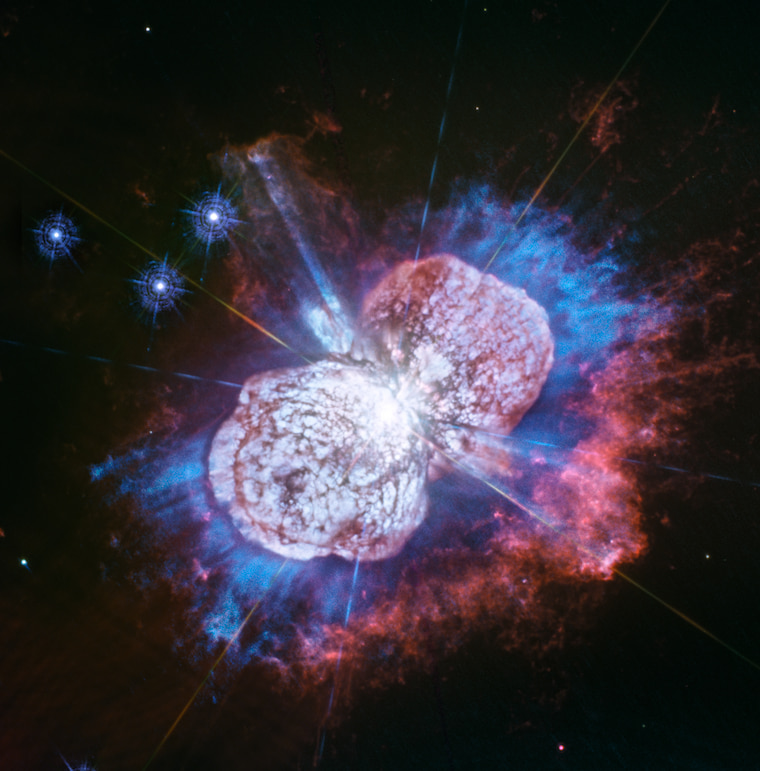Eta Carinae

Eta Carinae (η Carinae) is a really interesting star. Housed in the eerie, bi-polar Homonculus Nebula, which itself is a part of the larger Carina Nebula, Eta Carinae is a massive star with a mass of 150 - 250 times the mass of the sun, and is extremely luminous, producing the equivalent of 4.7 million suns worth of light. It is classified as a Luminous Blue Variable (LBV) star, typically characterised by erratic and extraordinary variations in their spectra and luminosity. When I first came to know about this star, it was considered a single star and a candidate for one of most massive stars ever discovered, with only proposals that it could be a binary star system, based on a 5.52 year periodic change in its spectra and near-infrared emission1. This was confirmed in 20052, and it is now considered to be at least a binary system with the more massive Eta Carinae A along with a smaller ~90 solar mass Eta Carinae B.
The most striking feature of this star system is the huge bi-polar reflection/emission nebula that the stars are ensconsed in, making direct observations of the stars near impossible. The nebula was created by the gas ejected from Eta Carinae during the Great Eruption event from 1838 - 1856. The dust in the nebula also absorbs much of the light emitted by the star system and re-radiates them in infra-red, resulting in it being the brightest object in the night sky in mid-IR wavelengths.3 The Great Eruption is the name given to the massive outburst of gas and debris starting in 1838 and lasting for 18 years till 1856. During this time, the star system outshone almost every other star in the sky, becoming the second-brightest star after Sirius. It also lost a lot of mass, at the approximate rate of 1 solar mass per year, to a total of 10-20 solar mass, much of which now forming the nebula. Events of these kind are very rare, and are dubbed as supernova imposters. A regular supernova would either destroy its progenitor star or leave a stellar remnant like a white dwarf or for bigger stars, an ultra-dense object like a neutron star or a black hole. A supernova imposter on the other hand releases the same levels of energy, possibly over a longer duration, but leaves its progenitor star intact. Interestingly, a supernova imposter is also alternatively known as an Eta Carinae analogue, after our beloved star.
This star system is also a treasure trove of eccentricities. It is the only astronomical object known to produce ultraviolet lasers.4 The bi-lobed structure of the Humonculus Nebula is novel, and in the middle is an equatorial skirt containing comparitively less dust and shining mainly by reflected light. The lobes have complex and irregular structures that have been mapped in great detail, so much so that you can 3D print it and have your own little Homonculus Nebula. On top of that, the bipolar nebula is angled so that the NW lobe is further away from our vantage point on earth than the SE lobe is. Since the whole nebula is expanding, the SE lobe is blue-shifted and the NW lobe is red-shifted, relative to the central source. The star system has also had a Lesser Eruption event in 1890, which would have produced luminosities even higher than the original eruption, but it was obscured due to the gas and dust produced in the previous eruption. In spite of that, it shined almost as brightly, though the amount of ejecta this time was relatively minuscule, at 0.1 solar masses.
Enormous stars like Eta Carinae are really rare and extremely short-lived on astronomical time-scales. They live short and furious lives, and go out in a blaze of glory. Hence, it is completely possible that we will get to see it implode in a supernova in our lifetime. What a sight that will be.
Footnotes
-
Damineli, A. (1996) The 5.52 Year Cycle of Eta Carinae [link] ↩︎
-
Iping, R. C.; Sonneborn, G.; Gull, T. R.; Ivarsson, S.; Nielsen, K. (2005) Searching for Radial Velocity Variations in eta Carinae [link] ↩︎
-
Smith, Nathan (2012). “All Things Homunculus”. Eta Carinae and the Supernova Impostors. Eta Carinae and the Supernova Impostors [link] ↩︎
-
Hubble Discovers Powerful Laser Beamed from Chaotic Star - NASA Hubble Site [link] ↩︎